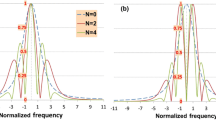Abstract
The minimum absorption detectable by a tunable diode laser spectrometer utilising harmonic techniques is often limited by interference fringes generated by scattered light. The sensitivity of the spectrometer to absorption can be increased by applying a jitter modulation. In this paper, the theory of harmonic response for single- and two-tone modulation over optical fringes and Lorentzian absorption lines is developed and compared to experimental measurements. A simple analytic expression for the two-tone harmonic line shape is derived. This expression provides a physical understanding of the effects of the second modulation, and a means to unravel the effects of the second modulation on the linewidth and line shape. For a specific choice of the jitter frequency and phase, it is possible to simultaneously minimise the fringe signal and increase the harmonic absorption signal. The results of this investigation are applicable to trace gas detection using tunable diode lasers, and to other areas of spectroscopy and magnetic resonance where harmonic techniques are used.
Similar content being viewed by others
References
J. Reid, J. Shewchun, B.K. Garside, E.A. Ballik: Appl. Opt.17, 300–307 (1978)
J. Reid, B.K. Garside, J. Shewchun, M. El-Sherbiny, E.A. Ballik: Appl. Opt.17, 1806–1810 (1978)
D.T. Cassidy, J. Reid: Appl. Opt.21, 1185–1190 (1982)
J. Reid, D. Labrie: Appl. Phys. B26, 203–210 (1981)
M.D. Miller, A. Pires, D. Chen, S.K. Poultney: Poster paper presented at the conference on High Resolution Infrared Applications and Developments, National Bureau of Standards, Gaithersburg, Maryland, June 23–25 (1980)
J. Reid, M. El-Sherbiny, B.K. Garside, E.A. Ballik: Appl. Opt19, 3349–3354 (1980)
Although the change in tuning rate affects both modulations equally when measured as a percentage change, the absolute change of the jitter modulation is insignificant in terms of the number of fringes modulated over. This feature renders the minimum of the two-tone harmonic response less sensitive to changes in the tuning rate
R.S. Loughurst:Geometrical and Physical Opties, 3rd ed. (Wiley, New York 1973) p. 180
G. Arfken:Mathematical Methods for Physicists, 2nd ed. (Academic Press, New York 1970) Chap. 11
R. Arndt: J. Appl. Phys.36, 2522–2524 (1965)
Author information
Authors and Affiliations
Additional information
This work was supported by the Natural Sciences and Engineering Research Council of Canada, and the Ontario Ministry of the Environment




